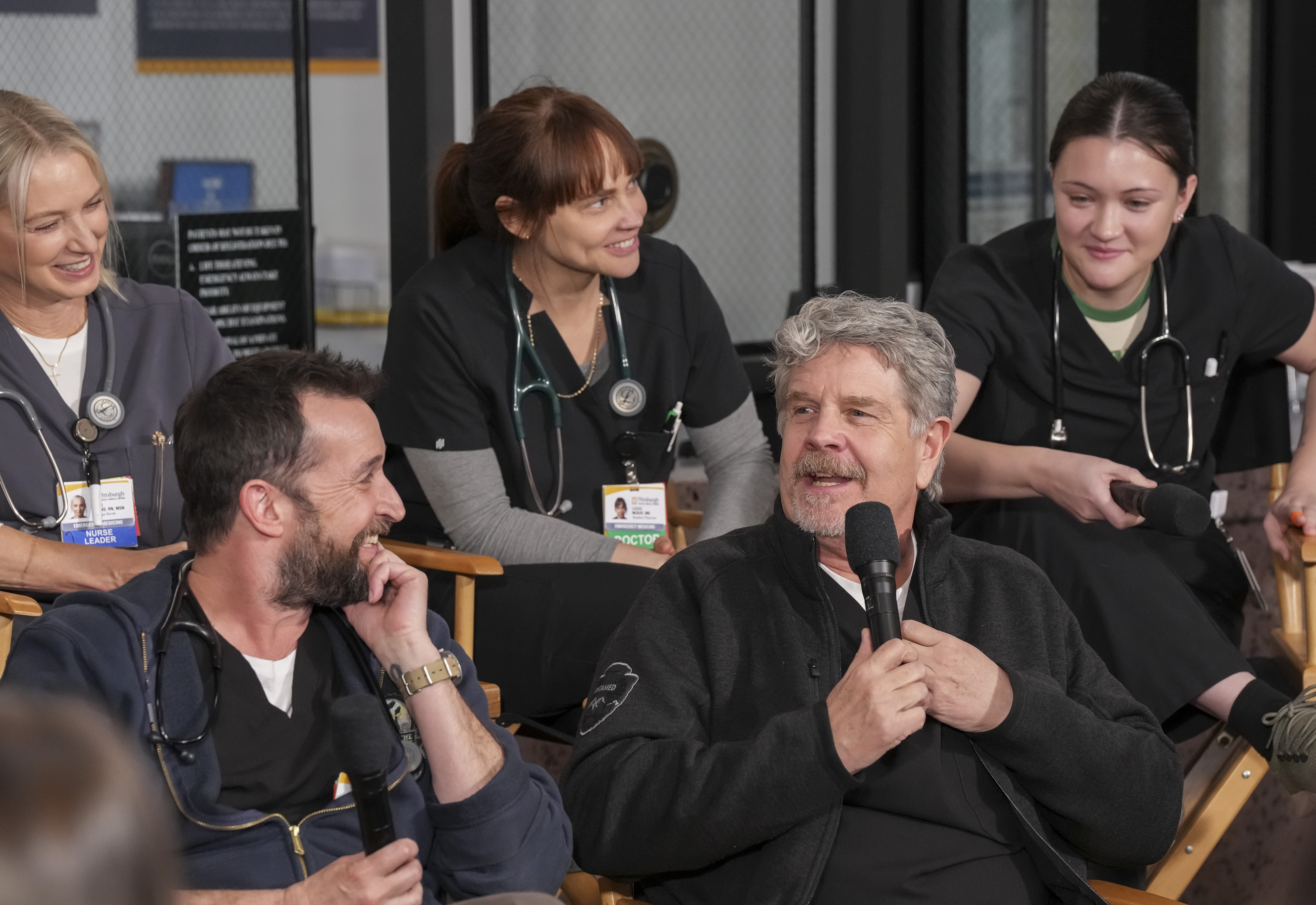Inside ‘The Pitt,’ a new spin on the medical drama

The cast and crew of “The Pitt” sit in front of a panel of journalists on the show’s set at Warner Bros. Studios Burbank. The new medical drama began releasing episodes on Max last month, with each episode chronicling a portion of a 15-hour emergency room shift at a Pittsburgh hospital. (Courtesy of Warner Bros. TV/Evans Vestal Ward)

By Reid Sperisen
Feb. 21, 2025 3:02 p.m.
It is time for television viewers to enter “The Pitt.”
The Max series, which has released eight episodes since its debut last month, is shaking up the medical drama category by exploring the emergency room in new ways. Each entry in the 15-episode first season is set to chronicle part of a 15-hour emergency room shift. R. Scott Gemmill is the series’ creator and a previous producer on the medical program “ER,” but he said he was initially hesitant to produce another medical drama.
“It was fun to reconnect with these guys and try to go back to a world that we had worked in before,” Gemmill said. “But how has it changed, what’s new and how can we do it in a new and exciting way? And that’s what we ultimately ended up with.”
An assortment of journalists attended a press event at the Warner Bros. Studios Burbank, which included a panel with the main cast and crew of “The Pitt,” to ask questions about the logistical orchestrations and character development making the new show possible. Lead actor Noah Wyle, who plays Dr. Michael Robinavitch, said it is simultaneously rewarding and uncanny to return to a role in a medical drama after 15 years spent on “ER” between 1994 and 2009. He said he has been able to play this role with more wisdom and maturity.
[Related: ‘Georgie & Mandy’s First Marriage’ is a spinoff for less-than-perfect people]
Katherine LaNasa, who plays nurse Dana Evans, said it was a combination of interactions with nurses in Los Angeles and her own life experiences that shaped her portrayal of her character. She said she noticed how nurses have to balance their empathy and compassion with efficiency in their work. The emergency room can be a battlefield with many moving parts that nurses have to process, LaNasa said, though she found herself well-suited for her role.
“I come up from a long line of … women who are also really maternal and loving,” LaNasa said. “It was a quality that I recognized in myself.”
Fellow cast member Isa Briones plays Dr. Trinity Santos on the show and said she is proud to star in a medical show that makes an effort to represent the diversity of employees within the medical field. As a Filipino person, she said she is grateful for the opportunity to portray a character that represents not only her family and friends in the Filipino community but also Filipino medical professionals and healthcare workers. Briones added that it has been a natural transition from her theater background for her to act on “The Pitt” because of the realism of the show’s sets.
“The way we do trauma scenes is so intensely rehearsed,” Briones said. “It is a dance, it is choreography. And we run it, run it, run it until it is in our bones.”

A somewhat unconventional component of the approach of “The Pitt” is that the series lacks music, Gemmill said. This choice was intentional and is made possible through fast-paced writing and emotional performances by the actors, he added. The absence of a score during tense scenes increases the realism of being in the emergency room and prevents audiences from being pushed back into their chair, Gemmill said, as people do not hear the sound of violins when receiving bad news at the hospital.
In addition to the interview panel with the show’s primary cast, the assembled group of journalists were led on a tour of the sets of “The Pitt” by production designer Nina Ruscio. Being able to move throughout the set seamlessly and film consistently was important to shaping her intentions with the set design, Ruscio said. Creating a playground for the actors to shine was her job within the production, she added.
[Related: UCLA alumnus Jeff Kmiotek prioritizes authenticity in TV with launch of ELIXIR]
A conscious effort was made to evoke the Pittsburgh setting that “The Pitt” takes place in, while also making the set feel as if it is underground, Ruscio said. This dual mission was achieved by placing columns in the set similar to those found at Pittsburgh’s Allegheny General Hospital, she said. The budget for “The Pitt” has been maximized and no penny has gone to waste, Ruscio added, with millions of dollars worth of real medical equipment donated for use on the show. The strategic design gives actors and crew members the ability to see through windows from one edge of the set to the other, she said, allowing not only multiple angles to be filmed at once but also increasing the immersion of the emergency room.
“There’s continuous motion, there’s activity in every corner of the frame,” Ruscio said. “Designing a set that made us all feel as if we were people that worked inside of an emergency department was part of the intent and exploiting the continuous physical design has, I think, served the show really well.”
Reflecting on the broader mission and importance of the show, Wyle said the problems surrounding health insurance that were discussed in the 1990s are just as relevant today, if not more so. He said he hopes “The Pitt” inspires viewers to pursue careers working within the healthcare system, especially as the healthcare industry continues to reckon with the effects of the COVID-19 pandemic.
“Part of doing this was to shine the spotlight back on this community and to hopefully inspire the next generation of healthcare workers to want to go into these jobs, because we are going to need them,” Wyle said. “Our system is fragile, and it is as fragile as the quality of support we give our practitioners.”





